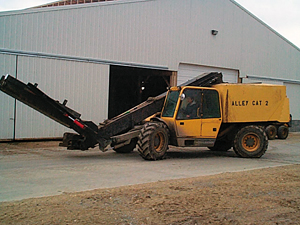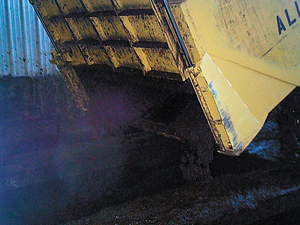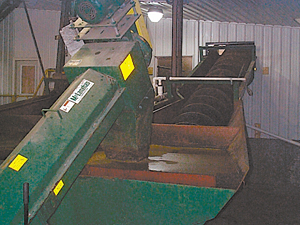
New York’s Marks Farms is using modern state-of the-art equipment and utilizing some old-fashioned ingenuity—including its own scraper—to handle manure from its large-scale dairy operation.
New York’s Marks Farms is using
modern state-of the-art equipment and utilizing some old-fashioned
ingenuity—including its own scraper—to handle manure from its
large-scale dairy operation.
Since David Peck, his wife Jackie and brother-in-law William Marks bought Marks Farms 20 years ago, it has grown significantly and is now one of the largest dairy operations in New York State. The 5,800-acre farm located in Lowville, NY has gone from 200 cows to milking 3,200 cows and houses a total of 5,500 head, including young animals.
But with size comes challenges. The area around the Marks farm is becoming a resort destination and odor is an issue. And like elsewhere around the country, environmental regulations are growing stricter. Two years ago Marks Farms realized an effective manure processing system was a necessity.
The dairy complex is spread out over approximately 12 acres, making it hard to move the manure to a central processing point. It would take some ingenuity and creativity to come up with the right solutions—something David Peck comes by in spades.
Step by step, they put their system together. “First we turned all of our barns into warm barns,” says Peck. “We get days here that are minus 35 degrees. We can’t process frozen manure.”
Peck and a friend had been toying with an idea for forced air ventilation. They decided to convert one of the barns and test their theory. “We were so successful with that one barn we said, ‘Let’s go ahead and finish all the rest of them,’” says Peck. A million dollars and a year-and-a-half later, all the barns were converted.
  The patented Alleycat machine (left) works like a vacuum tank, but modifications make it much easier to operate. It scrapes on a V angle that forces the manure toward the center of the machine. An elevator takes the manure and moves it into a 2,400-gallon container/unit. That box (right) then dumps into a 5,000-gallon receiver pit. The patented Alleycat machine (left) works like a vacuum tank, but modifications make it much easier to operate. It scrapes on a V angle that forces the manure toward the center of the machine. An elevator takes the manure and moves it into a 2,400-gallon container/unit. That box (right) then dumps into a 5,000-gallon receiver pit.
|
“We use a chimney-type ventilation system, but we power it,” explains Peck. “We have 56-inch fans every 16 feet down the center of the feed alleys to draw all the air from the side and send it out the top. We keep the sidewalls closed in the summer, except 18 inches at the ground level on the outside. That draws air in, right down the cow’s face, moves it across the floor and right up and out of the barn.”
In the winter they reverse the procedure. “We closed the bottom and the top of the side walls and we cut back to three fans running. Normally there are three fans running even when it’s minus 40. We keep the air high above the gals. And it keeps the air quality in the barns good.”
To test the effectiveness of the ventilation system, the farm overcrowded its two top production groups by 20 percent the first summer. Despite the overcrowding they maintained over 100-pound production.
The next step was to find a way to clean alleys more efficiently. At the time, the farm had three employees and three loaders running almost full time cleaning the barns—pushing manure out to a central pit that wraps around the barns. Again, Peck has been playing around with a design idea. He gave a local machinist his concept and together they got to work.
“I got tired of buying new trailers every two years. Finally we took a piece of equipment that wasn’t designed for cleaning—a brand new $60,000 piece of equipment—and we cut it apart. We just took everything we hated about manure handling equipment and tried to fix it.” The end results exceeded even Peck’s expectations.
“Instead of three guys running equipment all day trying to keep up, now we have one guy and he’s got extra time when he’s finished,” says Peck.
The patented machine, called the Alleycat, works like a vacuum tank, but modifications make it faster and easier to operate. “We have two adjustable wing blades that will adjust from a 14.5-foot wide alley down to an eight-foot alley. The two wing blades open up and adjust to the alley width. We have wheels on the outer blade that run against the curb, to protect the wings and to keep it from damaging either the wings or the curb,” says Peck.
The machine travels about two to three mph. It scrapes on a V angle that forces the manure toward the center of the machine, and an elevator takes the manure and moves it into a 2,400-gallon container/unit. That box then dumps at a 70-degree angle into a small 5,000-gallon receiver pit.
The machine was created with simplicity and a lack of driving experience in mind. Most of Marks Farms employees are Latinos who have never driven equipment before. Within a matter of few days, employees can operate the Alleycat with ease. Added benefits are a quarter of the fuel consumption, lower labor costs and a lot less worn tires.
The Alleycat has been so successful that it is drawing attention from other farmers. And Peck is considering producing them commercially.
With an effective way to get the manure to the receiving pit, the next issue was sand separation. They installed a grating system at the receiving pit. Now the manure first goes to grating to sift out any large items before processing. “We have one-inch spacing, so it catches all those things that aren’t supposed to be in the barn, but somehow get there,” says Peck.
 The Marks Farm has recently installed a McLanahan sand The Marks Farm has recently installed a McLanahan sand separation system. Each of the two SMS 36 sand separators can handle manure from roughly 3,000 cows a day. |
Then the manure is taken through a recently installed McLanahan sand separation system. Two 18 by 30 augers take the manure through two SMS 36 sand separators. Each sand separator can handle manure from roughly 3,000 cows a day and run 24 hours a day.
“One of the separators is more of a standby,” says Peck. “We’re one of those farms where we have secondaries in place for everything. I don’t want to hear that we can’t do something because a piece of equipment is broken.”
Once through the sand separators, the manure is taken through the hydro cyclone separator to remove the fines. The sand is taken to a pad where it is reused as bedding with the use of a McLanahan stall filter.
“The system paid for itself in six months,” explains Peck. “Currently we’re capturing about 90 percent of the sand. To give you an idea, we used to use about forty 15-yard truckloads of sand. Now, if we buy 200 yards a year we’d be lucky.”
Once through the sand separator, the effluent moves to the Press Technology processing system, which recently went into full operation. The system consists of an Internal Drum Thickener (IDT), an Agri-Press Screw Press, and a Dissolved Air Floatation (DAF) Clarifier. The manure is first fed into the IDT, which is about five feet in diameter and 36 feet long.
Some of the solids are left behind and the liquids then flow into the screw press where more separation occurs. Chemicals are added to the liquids coming off the drum thickener and screw press before being pumped into the DAF clarifier, where phosphorus and ammonia are removed and solids are dissolved. Once through the DAF clarifier, any solids are sent again through the screw press.
What is left is liquid with some remaining ammonia and nitrogen, but with 98 percent of the phosphorus and 70 percent of the potassium removed. That liquid, which looks like tea, is pumped to a 35 million-gallon storage pit and used as wash water for the sand, reducing the farm’s need for fresh water.
During the process, Marks Farms produces about five 45-foot walking floors of solids per day. The solids are sold to a company that does composting and mulching. “The material comes off our screw press and is automatically loaded to trucks and trailers and taken about 30 miles to the company,” says Peck.
This is hardly where the story stops. Creativity and innovation are the cornerstones of Marks Farms as they look to the future and the options on the horizon.
“Currently the farm spreads the liquid, but we’d like to ultimately stop spreading it. It’s odorless but people can see us spreading.
“We are in negotiations with Ducks Unlimited. We would like to take 300 acres of our property back to wetland and process the effluent through these wetlands. Ducks Unlimited are very interested in doing this and we’re kind of a test plot. ” Ducks Unlimited would like to put a nature trail through the wetlands and say, ‘This is a processing a product from a dairy farm and at the same time creating this wonderful wildlife habitat,’” says Peck. “We would very much like to accomplish something like that.”
And there are other tests going on at the Marks Farms. They received a $500,000 grant from the USDA and a $200,000 grant from New York State to do a pilot project involving digesters.
“We handle whey from cheese plants and that whey makes good methane gas. We mix it with manure and it makes even better methane gas. We’re currently running a pilot project that runs for six months to see what kind of a digester it would take, and what the economical payback would be,” says Peck. “Right now we have a mini digester set up inside a truck and trailer and we run different retention times, different types of batches and just try to find out what produces the best gas.”
Peck isn’t interested in the methane for energy. “I’d rather find someone else to deal with the methane. We can buy power cheaper than what we can make it for. We’d rather use it for something like sterilizing the solids. Sterilized solids have a high market value because universities and test companies want a sterile medium very badly. It’s something we’d like to do in the future.”
Although the farm is a model for innovation, Peck sees processing manure as an ongoing journey. “We think we’ll be successful, that’s why we’re doing it. Unfortunately, no one has a cookie cutter system that they guarantee will work on every farm. It’s a very slow process. We’ve been at it two years and I think we have about two more years to go until we have our system to the necessary level.”